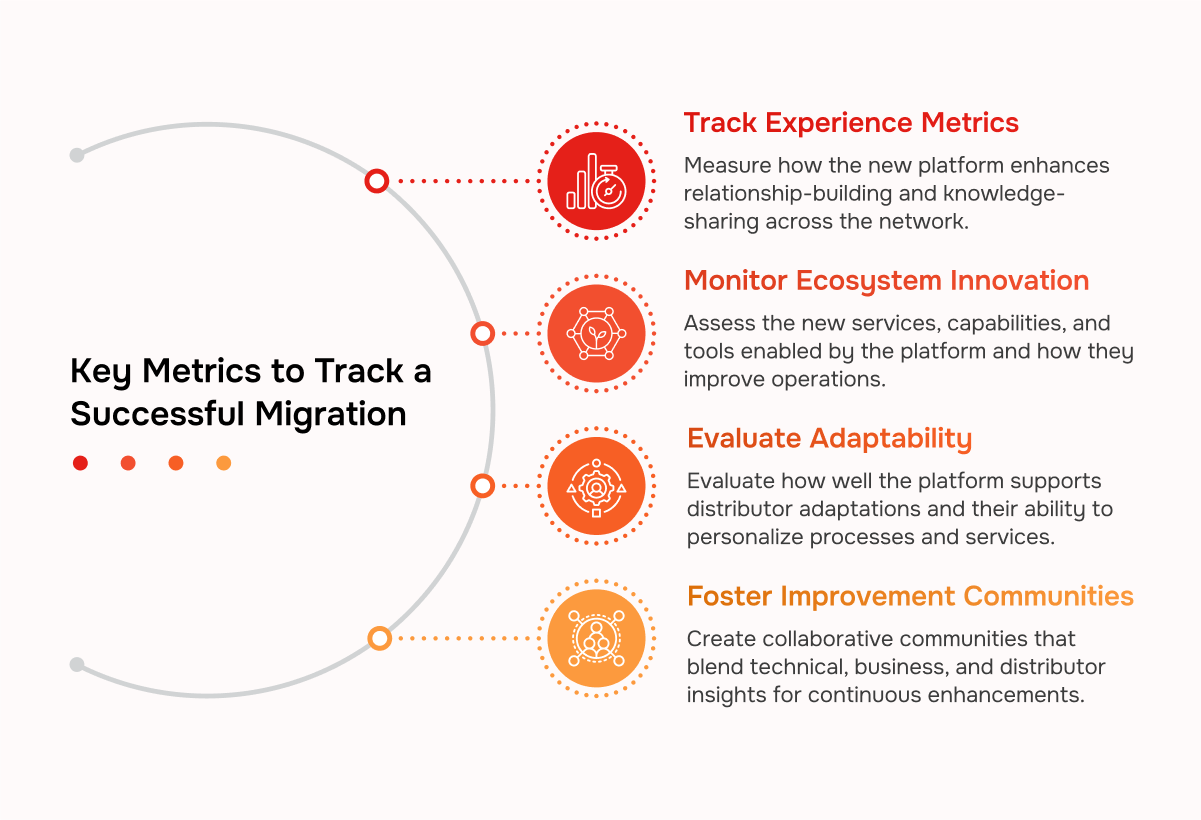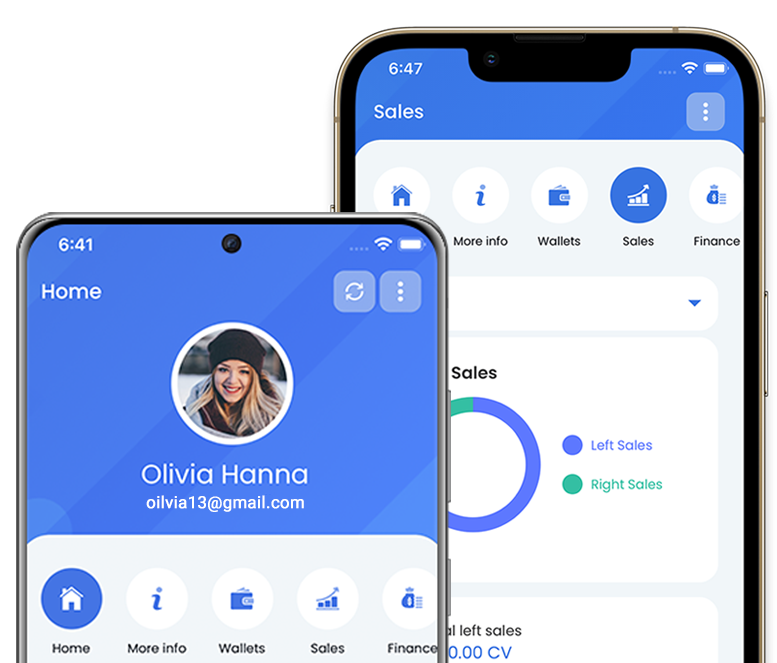Comprehensive MLM Software Migration Guide for Executives and Distributors

- Need for MLM software migration
- Pre-migration assessment
- Selecting the right MLM software
- Creating a migration strategy
- Implementation phase
- Regulations and risk management
- Change management and training
- International market considerations
- Post-migration support
- Measuring migration success
- Data analytics for ecosystem automation
- Conclusion
While migrating to a new MLM software system is essential, it is also time-taking. For direct selling executives, it raises concerns around data integrity, compliance, and operational stability. For distributors, even brief disruptions in access or unfamiliar interfaces can lead to confusion, and reduced sales. Despite these challenges, software migration is necessary for businesses planning to expand, strengthen security and improve overall performance.
Over 65% of MLM companies still work with outdated systems. The consistent struggle for compensation errors, and system downtime, leads to bad service and low profitability. But by opting for a software migration, MLM businesses can increase their performance up to 35%.
This guide takes you through all the steps of software migration—from identifying risks and planning strategically, to executing the transition. We will focus on technical features as well as on enhancing the operations.
What is the need for MLM software migration?
An MLM software migration is in order when your current platform starts limiting the growth and agility of your business. In a direct selling environment where the real currency is relationships and reputation, your software isn’t just a backend system—it’s the architecture through which distributors engage, sell, learn, and grow.
MLM organizations don't think of MLM software as a simple operational tool. For MLM companies, the software helps define the distributor experience, drive customer satisfaction, and support strategic decision-making. Here are some instances that help MLM businesses identify that a software migration is due:

Your system cannot support personalized, scalable functions across a company's departments.

Distributors are intervening in the operations to manage leads, sales, and customer support.

Ecosystem constraints prevent you from integrating with third-party logistics, payments, or training platforms that distributors rely on.

Innovation barriers surface when legacy systems can’t evolve with changing distributor expectations or new market opportunities.

Migration is the first step in re-aligning your tech with your mission: enabling trust-driven, value-rich exchanges at scale.
Key Indicators That a Software Migration is Due
- Lack of Scalability
- Manual Workarounds
- Integration Challenges
- Lack of Innovation
Pre-migration assessment and planning
A successful MLM software migration begins not with code or configurations, but with clarity—about your service ecosystem, distributor experience, and the specific value your platform must deliver. Before any technical steps are taken, it’s essential to assess how your current system supports or limits the intricate flow of relationships, knowledge, and transactions that power your direct selling model.
Rather than simply listing features to replicate, this stage is about understanding what your distributors truly need to grow and serve. It’s about designing your migration around moments that matter—those critical interaction points where your technology must empower, not obstruct.

Map the distributor journey to identify key interactions where MLM software can unlock or inhibit value creation.

Evaluate personalization limitations in your current platform that prevent tailored service delivery to diverse customer segments.

Assess knowledge flow by analyzing how easily distributors can access, share, and apply learning within your network.

Define experience metrics that prioritize seamless engagement, distributor autonomy, and high-quality customer touchpoints over backend efficiency alone.
This planning phase sets the tone for everything that follows—anchoring your migration in what truly drives growth: empowered distributors, enriched customer relationships, and a flexible tech foundation that supports both.
Selecting the right MLM software solution
Technology must do more than manage operations—it must actively enable meaningful service exchanges between distributors, customers, and corporate teams. The best MLM software platforms are no longer just transaction engines; they serve as relationship infrastructure, orchestrating every interaction that drives growth, trust, and loyalty.
As you evaluate potential solutions, the focus should shift from ticking off feature lists to understanding how each platform empowers your ecosystem. The right software is one that helps distributors personalize service, enhances team learning, and adapts to evolving business models—all while maintaining a seamless experience for every stakeholder.

Prioritize platforms that support personalized interactions and empower distributors to tailor their approach based on customer context.

Assess how the software enables continuous knowledge sharing and peer collaboration, not just static content delivery.

Look for adaptability—systems that evolve with shifting distributor needs, service innovations, and growth strategies.

Verify integration capabilities that allow you to embed external service providers into a cohesive distributor and customer experience.
Choosing a future-ready MLM solution means selecting a platform that strengthens every connection within your network and equips your organization to deliver value at every touchpoint.
Creating a migration strategy
An effective MLM software migration strategy goes beyond moving data—it’s about protecting and enhancing the human connections that drive your business. Your distributors aren’t just users of a system; they are relationship builders, community leaders, and service providers. A thoughtful migration plan must therefore focus not only on technical accuracy but also on maintaining the trust, collaboration, and continuity your network relies on.
The real measure of success isn’t just whether the data moves cleanly, but whether your distributors can continue creating and exchanging value without disruption. A strong strategy ensures the transition strengthens—not interrupts—the service experience.

Preserve relationship continuity by designing migration flows that protect trust and ongoing conversations.

Enhance co-creation capabilities, giving distributors tools to continue serving and supporting their teams and customers during the change.

Phase implementation by user experience, ensuring each group—distributors, leaders, and corporate teams—transitions smoothly.

Migrate social capital, not just data, by planning for how team dynamics, informal networks, and recognition systems carry over.
Your migration strategy should be more than a technical roadmap—it should be a service transformation plan.
Implementation phase execution
The implementation phase is where your migration vision takes shape—yet in direct selling, it’s much more than a systems rollout. It’s a live service experience involving everyone in your network. Success hinges on your ability to execute collaboratively across functions, ensuring that technical deployment doesn’t disrupt the human connections your business relies on.
The best MLM organizations treat implementation as a value creation journey, aligning the goals of IT teams, business leaders, and distributor communities. When executed thoughtfully, implementation not only installs a new platform—it strengthens your network’s ability to deliver exceptional, localized, and personalized service at scale.

Build cross-functional teams that unite tech execution with on-the-ground distributor insights.

Design collaborative testing to evaluate real-world usability and distributor experience—not just technical checkboxes.

Enable adaptive feedback loops that allow course correction as real-time insights surface from stakeholders.

Provide guided transitions for high-impact networks and top leaders to preserve performance and trust.

Implementation is your opportunity to align technology with people—to turn a system change into a step forward for your entire ecosystem.
Navigate your next migration with confidence—equip executives and distributors with the insights and strategies needed for a seamless MLM software transition.
Free DemoRegulatory compliance and risk management
MLM software migration offers a unique opportunity to not only strengthen your compliance infrastructure but also elevate your service model. Forward-thinking companies no longer view compliance as a regulatory hurdle; instead, they treat it as a core element that seamlessly integrates into their value creation process. By embedding compliance into every interaction, MLM organizations can transform it from a mere legal necessity into a competitive advantage that enhances trust and operational legitimacy across their network.
Design compliance features that guide distributors towards legitimate business practices, fostering a culture of transparency and integrity.

Implement transparent tracking that ensures compliance without compromising privacy or the quality of distributor relationships.

Create adaptive compliance frameworks that stay ahead of changing regulations, ensuring smooth transitions without disrupting core service functions.
Regulatory compliance isn’t just about avoiding risks—it’s about creating an environment where your network can grow with confidence and trust.
Change management and training
A successful MLM software migration is the result of how well the distributors adapt to the new functionalities. Effective change management goes beyond traditional training. It focuses on how the new platform enhances the overall service experience. Adoption of new MLM software is not just driven by incentives or mandates, but also by illustrating how the new tools can empower distributors to strengthen relationships, share knowledge, and deliver personalized experiences. Modern MLM software can equip your business with the following functionalities:
Frame change communications around how the new system enhances value creation rather than just focusing on technical features.
Study material that helps distributors understand how the new platform can help with customer relationship management.
Create collaborative learning environments where distributors can share insights and innovative ways to apply the technology in customer interactions.
Offer specialized support to key influencers within the network who serve as knowledge brokers, helping ease the transition and maximize adoption.
International market considerations
For cross-border or international MLM businesses, software migration is a must-have, if they want to scale and work in different markets across the globe.
Instead of forcing a one-size-fits-all solution, MLM companies should opt for software that helps them adapt to regional differences. Following are some functionalities you can expect from your new MLM software if you go for a software migration:

Develop market-specific experience maps to understand unique value exchange patterns in different regions.

Create adaptable interface layers that reflect cultural differences in relationship-building without requiring significant platform customization.

Implement modular compliance tools to meet regional regulations with global operations. This helps your business remain legally compliant across countries without creating separate entities every time you expand to a new market.

Design phased rollout strategies that preserve global platform integrity while addressing market-specific implementation needs.
Go-live and post-migration support
Transition to a new MLM software platform is difficult and inconvenient for the business and the teams. During this phase, technical stability and support for the reconfiguration of the new platform should be the primary focus. Additionally, provide your team with the time and patience to adapt to the new software.
The initial weeks after Go-live are crucial, as they determine whether the migration fosters innovation in how distributors engage with customers or leads to disruptions that can damage your company's market standing and reputation.
Here's what you can do during the Go-live phase to make the transition easy:

Implement experience monitoring to track relationship-focused metrics, not just technical performance.

Deploy specialized support to help maintain relationships during the transition and preserve social capital within distributor networks.

Set up fast feedback channels to gather performance reviews and share new ways to use the platform effectively across teams. This helps everyone to learn and adapt in a leaner time frame.

Establish cross-functional experience teams that are empowered to resolve issues affecting distributor-customer interactions promptly.
Measuring migration success
You can tell that a software migration was executed positively by how well the new platform enhances the ability of every participant in your ecosystem. MLM organizations today know that we cannot judge success by traditional metrics such as system uptime or cost savings alone. Instead, we focus on whether the transformation impacts the quality and diversity of interactions within the network in a positive or a negative way. This perspective provides companies with ample room for criticism, and improvement, which is driven by collaboration between technology providers, corporate teams, and distributors. This ultimately betters the overall migration experience which in turn builds the foundation of adaptation to the new technologies in the company.

Implement experience metrics to track how technology enhances relationship-building and knowledge-sharing.

Monitor ecosystem innovation by assessing the new services and capabilities enabled by your platform.

Evaluate adaptations as indicators of how effectively the platform supports personalized functions.

Create collaborative improvement communities that blend technical, business, and distributor insights for continuous service enhancements.
With these ongoing measures in place, you can ensure that your migration remains a long-term success, fostering continuous innovation and value creation across your MLM network.

Data analytics for ecosystem automation
MLM platforms offer advanced functions to businesses to help them build an intelligent ecosystem. This provides a deep understanding of how value flows through your network and how customer relationships evolve. Unlike traditional business intelligence, which focuses primarily on transaction data, ecosystem intelligence uncovers the intricate web of interactions, knowledge exchanges, and value co-creation that constitute your true competitive advantage. When effectively utilized during and after migration, these insights can transform your organization. From merely a product distributor into an orchestrator of value-driven relationships and experiences—your company can grow exponentially.

Design analytics frameworks to track relationship development patterns, moving beyond compensation qualification metrics.

Implement predictive models that identify emerging service innovations within your distributor network.

Create visualization tools that make relationship patterns visible to both distributors and corporate teams.

Develop intervention frameworks that proactively address struggling value networks before financial indicators show problems.

By putting analytics into implementation, your organization can continuously refine and strengthen its network for an efficient MLM business.
Ready to upgrade your MLM platform? Discover how a well-planned migration empowers leadership and elevates distributor experiences across your entire network.
Discover MoreConclusion
MLM software migration is more than a tech upgrade—it's an opportunity to transform how value flows within your organization. When viewed as a way to enhance relationships, knowledge-sharing, and personalized experiences, it drives true innovation.
This guide focuses on improving the migration experience and turning it into a strategic asset that strengthens relationships and boosts business growth. Migration pushes businesses to reimagine how they deliver value, connects distributors, customers, and the teams.
